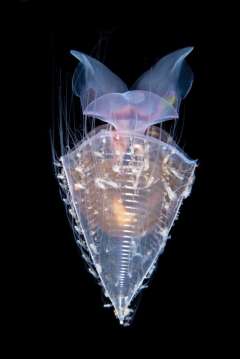Vote for the "International Mollusc of the Year 2024"
Online public voting starts today
Which mollusc will be the „International Mollusc of the Year“ in 2024? From today, everyone interested can take part in the global online public vote. This year marks the fourth round of the competition, which was launched by the Senckenberg Society for Nature Research, the LOEWE Centre for Translational Biodiversity Genomics (TBG) and Unitas Malacologica, the world mollusc society. The aim is to help the large and species-rich group of molluscs gain more attention and protection. The winning species will have its complete genome sequenced.
Five very different species have made it to the finals this year in the race for the title of „International Mollusc of the Year 2024“: the Wavy Bubble Snail (Micromelo undatus), the “Living Glow Stick” (Phuphania crossei), the Coosa Fiveridge (Amblema elliottii), the Wavy Sea Butterfly (Clio recurva) and the Atlantic Brief Squid (Lolliguncula brevis). They were selected from more than 50 nominations by a jury of scientists from the three partner institutions Senckenberg, LOEWE Centre TBG and Unitas Malacologica. „Once again this year, we are delighted with the species that have been nominated from all over the world. The diversity in the mollusc phylum is so great, and there are many fascinating characteristics to discover,“ says Dr Carola Greve, head of the laboratory centre at the LOEWE Centre TBG. „However, as complete genome sequencing is only available for relatively few molluscs, we want our competition to contribute to a better understanding of this animal phylum at the genomic level of species diversity and to be able to trace evolutionary developments, relationships and adaptive abilities“.
What molluscs have in common is that they have neither bones nor teeth and their body consists of a head and a „foot“ – a strong muscle for locomotion. Most species have a shell and live in water. Apart from this, these creatures, which form the second largest animal phylum after arthropods, differ in many aspects such as size, shape, behaviour, and preferred habitats.
This year’s five finalist species also reflect this diversity. They include three very different snails, a bivalve mollusc, and a small octopus. While the land-dwelling snail species Phuphania crossei, which can glow in the dark, is found exclusively in Thailand, the colourful, carnivorous Wavy Bubble Snail (Micromelo undatus) is found in shallow waters of the Atlantic Ocean. The Wavy Sea Butterfly (Clio recurva) floats through both the Atlantic and the Pacific Oceans with its triangular-shaped, flexible body. The freshwater mussel Amblema elliottii from the US state of Alabama surprises with an unusual life cycle. The Atlantic Brief Squid (Lolliguncula brevis) is the fastest invertebrate and is very adaptable to different salt concentrations in the water.
Short portraits on the voting website provide information on the characteristics and special features of the nominated species as well as the secrets that an analysis of the species‘ genomic material could reveal: https://www.senckenberg.de/en/molluscoftheyear2024
„Our aim is to draw attention to this extraordinary animal phylum and to raise awareness of the need to protect these animals. And, of course, we also want to promote research into different mollusc species,“ emphasises Prof. Dr Julia Sigwart, Section Head of Malacology at the Senckenberg Research Institute and Natural History Museum Frankfurt. „Although molluscs evolved around 500 million years ago, they are still a largely unexplored group of animals, especially from a genomic perspective. Many species are still waiting to be discovered.“
Voting will run from 13 March to 14 April 2024 at 23:59 (CET) on the website of the Senckenberg Society for Nature Research under the link
https://www.senckenberg.de/en/molluscoftheyear2024
The „International Mollusc of the Year 2024“ will be announced on 18 April 2024.
Information on the previous rounds of the competition:
https://tbg.senckenberg.de/mollusc-of-the-year/


